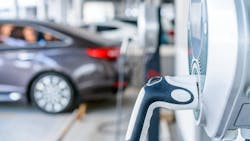Often, when trying to make a point about how far technology has advanced, it’s tempting to compare today’s world to that of the one decades ago. Twenty-year lookbacks are incredibly common, and for good reason–the world is vastly different now than it was in 2004.
Back then, MySpace was in its infancy (as was the whole concept of social media), iPods and DVDs were the primary media to listen to music and watch movies, and Apple was three years away from unveiling the iPhone.
The same is true for the automotive sector. In 2004, the Toyota Prius accounted for more than half of all hybrid vehicle sales with nearly 54,000, and Tesla was still four years away from delivering its first vehicle.
While those comparisons can prove insightful at times, however, they can gloss over just how quickly an industry, and the world, can change. Think about all the changes you’ve seen in your shop in just the past two to five years.
The National Highway Traffic Safety Administration only began requiring vehicles under 10,000 pounds to have a backup camera in 2018. Most advancements in higher levels of ADAS have only really made noticeable strides in the last three years. Electric vehicle manufacturers have only had a serious presence in the industry for two or three years, Tesla notwithstanding.
So much can–and has–changed since the turn of the decade in the automotive repair industry. But everyone knows that. Hearing someone making a big deal about the industry changing is cliché at this point, so why even bring it up?
Rick White, president of business management consulting firm 180BIZ, says that it’s a point that a lot of people in the industry are missing, whether they know it or not. He says a notable number of shops he’s worked with are stuck in the past, either through ignorance or arrogance, and are still running things the way they have for the last 20 years.
“There are still some shops out there that are handwriting repair orders. Look at today’s vehicles, the number of computers and components in them, that’s not going away,” White says. “If you’re a shop that’s working on cars that are 20 years old or older, is that a choice, or is it because you don’t have the proper equipment and the training? Technology is not a one-off. It should be a part of a plan.”
Vic Tarasik, founder and managing partner of Shop Owner Coach, says that some shops are taking the advances in technology for granted and are operating under the assumption that business will continue to just roll in because it always has, regardless of the ability of the shop.
“They look at technology just being in the bays,” Tarasik says. “Technology is not a boogeyman–the main purpose of technology is to increase efficiency and productivity. It’s crucial to the survival of the business. You can’t have a shop today and not adopt technology and expect to thrive.”
Adopting a technology mindset is not only an attainable goal for any shop, regardless of their starting point, but also a necessity to stay in business for the next 20 years and beyond.
Do Your Homework
Though it may feel like it at times, your shop doesn’t have to buy its way into a tech mindset. White says sometimes buying too many new tools or other technology can be a detriment if you and your team don’t have a plan for it.
“Some of us feel like whoever has the most tools wins, but that’s not the case,” White says. “I love to see a shop invest in technology, but you have to make sure there’s a market for it and that you’re not going into debt to acquire it.”
A technology mindset starts with planning and some good, old-fashioned research. Getting even the most basic understanding of what technologies are coming into your shop and what customers might need can help form a plan for your shop’s technology needs.
“Do your homework before you invest in the technology. To spend thousands of dollars on training for EVs when less than 1% of vehicles on the road are EVs, it’s not sustainable,” White says. “ADAS is a solid investment, and as we get to copilot and driverless technology, it becomes even more important. Do your homework. Make sure you have a market.”
And this doesn’t just apply to EVs. White says this research into what services you provide and what additional services your customers may need can help guide many decisions when planning out what technology to invest in.
“Let’s say there’s a shop that isn’t doing alignments that wants to get a $90,000 lift. How many alignments do you have to do to make that worth it?” White asks. “And you can’t just take all the money that you make and put it toward the cost of the machine. There’s a lot of other stuff to it.”
Staying in the know about the needs of your customers will help identify the tools your shop should invest in. And, if investing in that equipment makes sense for your shop, there are also smart ways to make those purchases more affordable. White recommends putting a small amount–say 3% to 5%– of sales into an account designated specifically for technology and tooling purchases. If you do it regularly, your shop might feel it for a little bit, but after a while, it becomes second nature. And, pretty soon, your shop will be able to buy new tools outright without having to scramble to find money.
“How cool would it be to be able to cover something upfront instead of having to get a monthly payment?” White says. “The problem is we all want it now. If we can give ourselves the gift of patience and start a budget, it helps.”
And though you may ultimately be the one writing the check to purchase new technology or tools, you don’t have to be the only one making the decision.
White says the easiest way to get team buy-in on major investments is to let them help make the decision. Your technicians will know what your shop needs the most and where improvements can be made.
“When I’m buying new equipment, my team is totally involved,” White says. “Get the team involved, figure out where they’re struggling the most, and develop a plan from there.”
A Different Kind of Social Media
Whether your shop is in a good position or it's playing catch-up to get up-to-date on the latest technology, it can be daunting to lead the charge. When you invest in new technology, tools, or training, you know it’s not just your livelihood that’s on the line. Your whole team is dependent on that decision to work.
Tarasik says that pressure can lead people to make less-than-ideal and sometimes desperate decisions when they don’t need to. He encourages shop owners to contact other shops in their area to see what they’re doing and how they’ve handled certain challenges. The first step in dealing with that pressure, he says, is to remember that you don’t have to do this by yourself.
“Don’t feel like you’re the tip of the spear. Spend time with someone who has already been down that road. Surround yourself with good people from different training organizations, Facebook groups, trade shows, and other places. Spend time with someone else and walk in their shoes.”
White says getting up close and personal with new equipment and technology is crucial. Industry trade shows and other events are prime places to start to get an understanding of what technology is out there and what might be useful for your shop.
“You can start to see some of this technology, and then from there, make sure you know how the system works and what the return is,” White says.
Invest in Your People
An owner or manager can only do so much to establish a culture of technological learning on their own. Bill Haas, owner of Haas Performance Consulting, says there isn’t enough time in the day for one person to be able to effectively develop and implement a technology strategy for a shop.
“Unfortunately for the people that are making the decisions, they're so busy in the business that they can't spend their time on the business,” Haas says. “(They aren’t) able to do the research and evaluate what direction they need to go in. They don't have the time to do it well.”
Haas says you need a good team in place with a good support system to help attract new talent and establish a strong working environment that can not only adapt to new changes in the industry but to thrive while doing so.
“You have to be a shop that’s willing to invest in your people. You have to pay them well. You have to give them a great benefits package. That has to happen first. When it does, you’ll have plenty of people who are excited to work in this industry.”
Training and development need to be a part of your shop’s offer to technicians and other employees. The only way that your shop will be able to retain high-quality talent and keep up with growing technological trends is if your team is eager to take on those challenges.
“Find people on your team who are curious about certain aspects of the technology in these cars. Then, make them the people who go to trainings and trade shows,” Haas says. “Let them get as much information as they can, and then as a team you can collaborate and figure out which way to go."
A technology mindset comes down to two crucial things–understanding the needs of your customers and the strengths of your team. If your shop can invest in tools that you know your customers need while maintaining a staff of techs who are eager to learn, you’ll be in a good position to take on any new technology that might come your way.
Adopting new technologies, Haas says, is no longer an option.
“We have to get out of the mindset of fixing broken cars. We are in the technology business. Technology is integrated into every part of the car now. There's a computer that manages every function of the car,” Haas says. “How are we not a technology business?”
About the Author

Noah Brown
Noah Brown is a freelance writer based in St. Paul, Minnesota. He has covered the automotive aftermarket and vehicle technology sector since 2021.
